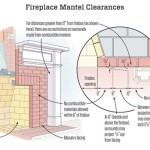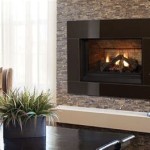Renovating Brick Fireplace Ideas: Enhancing Your Home's Focal Point
A brick fireplace is often a prominent feature in a living space, radiating warmth and character. However, over time, its appearance can become dated or simply no longer align with evolving aesthetic preferences. Renovating a brick fireplace presents an opportunity to revitalize the room, creating a fresh, modern, or classic look that complements the overall design of the home. This article explores various ideas and considerations for renovating a brick fireplace, examining techniques, materials, and stylistic choices to help homeowners make informed decisions about their renovation project.
Understanding the Existing Structure and Planning
Before embarking on a brick fireplace renovation, a thorough assessment of the existing structure is crucial. This involves inspecting the brick for cracks, crumbling mortar, or any signs of structural damage. Addressing these issues prior to any aesthetic changes ensures the longevity and safety of the fireplace. Furthermore, understanding the fireplace's functionality is essential. Is it a working fireplace that requires regular maintenance, or is it purely decorative? The answer will influence the choice of materials and the scope of the renovation.
Planning is a critical stage. It involves defining the desired aesthetic, considering the budget, and selecting appropriate materials. Architectural style of the house should guide the design choices. A modern home may benefit from a minimalist approach, while a traditional home might call for a more ornate design. Consider the surrounding décor and color palette to ensure a cohesive and harmonious look. Moreover, setting a realistic budget is vital, as renovation costs can vary significantly depending on the complexity of the project and the materials chosen. Obtaining quotes from multiple contractors is advisable to get an accurate estimate of the expenses involved.
Safety considerations are of paramount importance. When working with fireplaces, especially working ones, it's recommended to consult with qualified professionals, such as chimney sweeps or fireplace installers, to ensure the renovation complies with safety standards and building codes. Working with fire-rated materials is essential, and proper ventilation should be maintained to prevent the buildup of harmful gases. If the fireplace uses gas, a qualified gas technician should be involved in any modifications or repairs.
Techniques for Updating Brick Fireplaces
There are several techniques available for updating the appearance of a brick fireplace. These range from simple cosmetic changes to more extensive structural alterations. The choice of technique will depend on the desired aesthetic, the condition of the existing brick, and the homeowner’s budget and skillset.
Painting: Painting the brick is a popular and relatively cost-effective way to transform the look of a fireplace. Before painting, the brick must be thoroughly cleaned to remove any soot, dirt, or grease. A primer specifically designed for masonry should be applied to ensure proper adhesion of the paint. Choose a high-quality, heat-resistant paint in a color that complements the room's décor. Consider using different paint finishes, such as matte, satin, or gloss, to achieve the desired effect. White paint can create a clean, modern look, while darker colors can add drama and sophistication.
Whitewashing: Whitewashing is a technique that involves diluting paint with water and applying it to the brick, creating a translucent effect. This can soften the appearance of the brick while still allowing its natural texture to show through. Whitewashing is a good option for those who want to lighten the brick without completely covering it. The level of translucency can be adjusted by varying the ratio of paint to water. A similar technique, called German smear, involves applying a layer of thinned mortar over the brick, creating a rustic, aged look.
Adding a Mantel: Installing a mantel above the fireplace is a classic way to enhance its visual appeal. A mantel can be made from a variety of materials, including wood, stone, or metal. The style of the mantel should complement the overall design of the room. A simple, clean-lined mantel can add a touch of modern elegance, while a more ornate, carved mantel can evoke a traditional feel. The mantel can also serve as a display surface for decorative items, such as candles, vases, or artwork.
Installing a Fireplace Insert: A fireplace insert is a self-contained unit that fits inside the existing fireplace opening. Inserts can be powered by gas, wood, or electricity and offer increased efficiency and heat output compared to traditional open fireplaces. Installing an insert can also improve the safety of the fireplace by reducing the risk of sparks and embers escaping into the room. When selecting an insert, consider the size of the fireplace opening, the desired heat output, and the fuel type. A qualified professional should install the insert to ensure proper ventilation and safety.
Refacing with Stone or Tile: Refacing the brick fireplace with stone or tile is a more extensive renovation that can completely transform its appearance. Stone and tile offer a wide range of colors, textures, and patterns, allowing homeowners to create a truly unique and personalized look. Natural stone, such as granite, limestone, or marble, can add a touch of luxury and sophistication. Tile, such as ceramic, porcelain, or glass, offers greater versatility and can be used to create intricate designs and patterns. Refacing requires careful preparation of the surface and the use of appropriate adhesives and grouts. This type of renovation is often best left to experienced professionals.
Material Selection and Design Considerations
The choice of materials plays a significant role in the overall look and feel of the renovated fireplace. Different materials offer different aesthetic qualities, durability, and maintenance requirements. Careful consideration should be given to the materials used for the fireplace surround, mantel, and hearth.
Brick: While the existing brick is being renovated, it's possible to choose to either retain it or replace it at specific spots. If the renovation involves adding new brick, it's paramount to match the existing brick in terms of color, size, and texture. However, homeowners can also choose to introduce a contrasting brick for a more modern look. Reclaimed brick can add character and charm to the fireplace, while new brick offers a more uniform and consistent appearance.
Stone: Natural stone is a popular choice for fireplace surrounds due to its durability, beauty, and natural variations. Various types of stone are available, including granite, limestone, slate, and marble. Each type of stone has its own unique characteristics and aesthetic qualities. Granite is known for its durability and resistance to heat, while limestone offers a softer, more textured look. Slate is a versatile option that can be used for both traditional and modern designs. Marble is a luxurious choice that adds elegance and sophistication to any space.
Tile: Tile is a versatile material that offers a wide range of design possibilities. Ceramic and porcelain tiles are durable, easy to clean, and available in a variety of colors, patterns, and sizes. Glass tiles can add a touch of modern elegance and can be used to create intricate mosaics. Metal tiles can add a touch of industrial chic.
Wood: Wood is a classic material for fireplace mantels, adding warmth and character to the space. Different types of wood offer different aesthetic qualities. Oak is a strong and durable wood with a distinctive grain pattern. Pine is a softer wood that is easy to work with and can be stained or painted to match any décor. Reclaimed wood can add a rustic, weathered look to the fireplace.
Metal: Metal can be used for fireplace mantels, surrounds, or accents, adding a touch of industrial chic or modern elegance. Steel, iron, and copper are popular choices for metal fireplace elements. Steel can be used to create sleek, minimalist designs, while iron adds a more rustic and industrial feel. Copper can add warmth and richness to the space.
Beyond materials, design considerations such as shape, proportion, and symmetry are vitally important. The shape of the fireplace should complement the architectural style of the room. A tall, narrow fireplace can add height to a room, while a wide, low fireplace can create a more grounded and inviting feel. The proportions of the fireplace should be balanced and harmonious. The size of the mantel should be proportional to the size of the fireplace surround. Symmetry can create a sense of order and balance, while asymmetry can add a touch of visual interest.
Lighting is another important consideration. Installing lights above or beside the fireplace can highlight its features and create a warm and inviting atmosphere. Recessed lighting can provide ambient illumination, while spotlights can be used to focus on specific details, such as artwork or decorative items. Fireplace screens and other accessories can also enhance the look of the fireplace and add a personal touch.

10 Fireplace Makeover Ideas Before And After Regency

40 Brick Fireplace Ideas Captivating Showstoppers With Timeless Charm Makeover White

Brick Fireplace Makeover Before And After Decorating Painting Id Painted Fireplaces Paint

How To Paint A Brick Fireplace

16 Red Brick Fireplace Makeover Ideas

Brick Fireplace Makeover Before And After Ideas Cool Makeovers Remodel Home Red Fireplaces
:max_bytes(150000):strip_icc()/MadetobeaMommaBefore-5bb2476446e0fb002607ad4f.jpg?strip=all)
Before And After Fireplace Makeovers

25 Beautiful Diy Brick Fireplace Makeovers

Fireplace Makeover Ideas Bright Green Door The Lettered Cottage

7 Beautiful Ideas For Painting Interior Brick Fireplaces
Related Posts








